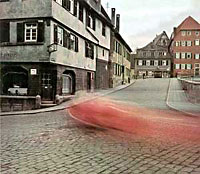 |
|
UTOPIA STATION SindelfingenUTOPIA STATION, curated by Molly Nesbit, Hans Ulrich Obrist and Rirkrit Tiravanija, is an international project which was first presented as an exhibition at the Venice Biennale in June 2003. UTOPIA STATION now opens an off-spring in Sindelfingen directed by Ingrid Burgbacher-Krupka with works by Michael Beutler, Ross Birrell, Natascha Sadr Haghighian, Tino Sehgal, the UTOPIA STATION posters (see http://www.e-flux.com) and a program of lectures, readings and film screenings. Collaboration with the Haus der Kunst in Munich and a reflection on the photo project “Imagine your photos will open my eyes” (GTZ Berlin and patronage by Yoko Ono) reach further out. In Sindelfingen in the southern part of Germany UTOPIA STATION meets the "small boom town at a cross road". During the economic growth after World War II, Sindelfingen became the wealthiest city of Germany and with the rise of globalization one of the poorest today. In 1955 a Yankee nomad David Douglas Duncan came to Sindelfingen to photograph the newest Mercedes sports car. Impressed by the collision of medieval and modern world in the city he set up a picture that hasn’t lost its intensity and wit to the present day. "He is a fool", commented the press officer, as Duncan knocked on the doors of the huge Mercedes assembly plant (now DaimlerChrysler, a giant, willing to grow further) asking for the fastest car with the fastest test driver, who could race in half a second shutter time 30 meters in the Old Town. He didn’t want to photograph the car (as asked by the press officer) but its ghost! Sindelfingen, the largest Mercedes assembly plant worldwide surrounded by extensive high tech (HP, IBM) stands for PRODUCTION. Production is the deep imprint and impulse of TINO SEHGAL’s art. Raised in Sindelfingen, he questions historical modes of production that transforms material or natural resources into supply goods. Whilst an object related work a priori affirms structures, since it mirrors, is involved in and thus promotes the transformation of material (the historically prevalent mode of production), dance, singing and verbal articulation are alternative modes of production which focus on transformation of acts to produce and deproduce at the same time. Thus 'PRODUCTION DEPRODUCTION' will be the theme of his talk in the gallery accompanied by a new poster presentation: "My poster is a poster that does not exist and the poster reads: THIS IS UTOPIA". NATASCHA
SADR HAGHIGHIAN addresses economic processes 'present
but not yet active'. When something is dropped out of the logic
of utilization, it becomes invisible, i.e. present but not yet active.
At this point everything starts to be possible. MICHAEL BEUTLER focuses besides the social and historical realm on the architectural context, "in fact, architecture largely develops out of the other two areas. I try to uncover that and adjust it". 'EIMER IMER MER' is the title of his working in situ in Sindelfingen - a rather poetical play on words than a statement that the whole world is in a mess. Beutler’s transformation and occupation of the place by using what’s there in some kind of a “do-it-yourself” method will also include the Venice Utopia posters. But he is not aiming for trash aesthetic but rather trying to conceptualize on the material for a result being more of a product of logical, economic processes, as it becomes quite clear in his working machines. "In many cases, because these objects not only have to be habitable, but also specifically transportable and easily set up, they have something like a double functionality: I like the ideas and utopias that are behind this, the belief that it is great to be everywhere at the same time". ROSS BIRRELL undertakes a series of journeys in order to deliver a package or gift to a specific institution (gifting a copy of Thomas More's Utopia to the International Court of Justice, the Hague and to the United Nations, New York) or traveling to a specific site in order to throw a sealed package or symbolic object into the sea, or simply reading certain texts in significant cultural or political contexts, each action references the failure of utopian 'grand narratives' of modernity and democracy. These works combine the individual and the ideological in an exploration of the social function of the artist - as a 'courier' of packages and objects or as an 'ENVOY' sent by an unknown power for an unspecified end. |
< return |
||
|
||
| < return | ||
|
|
||
